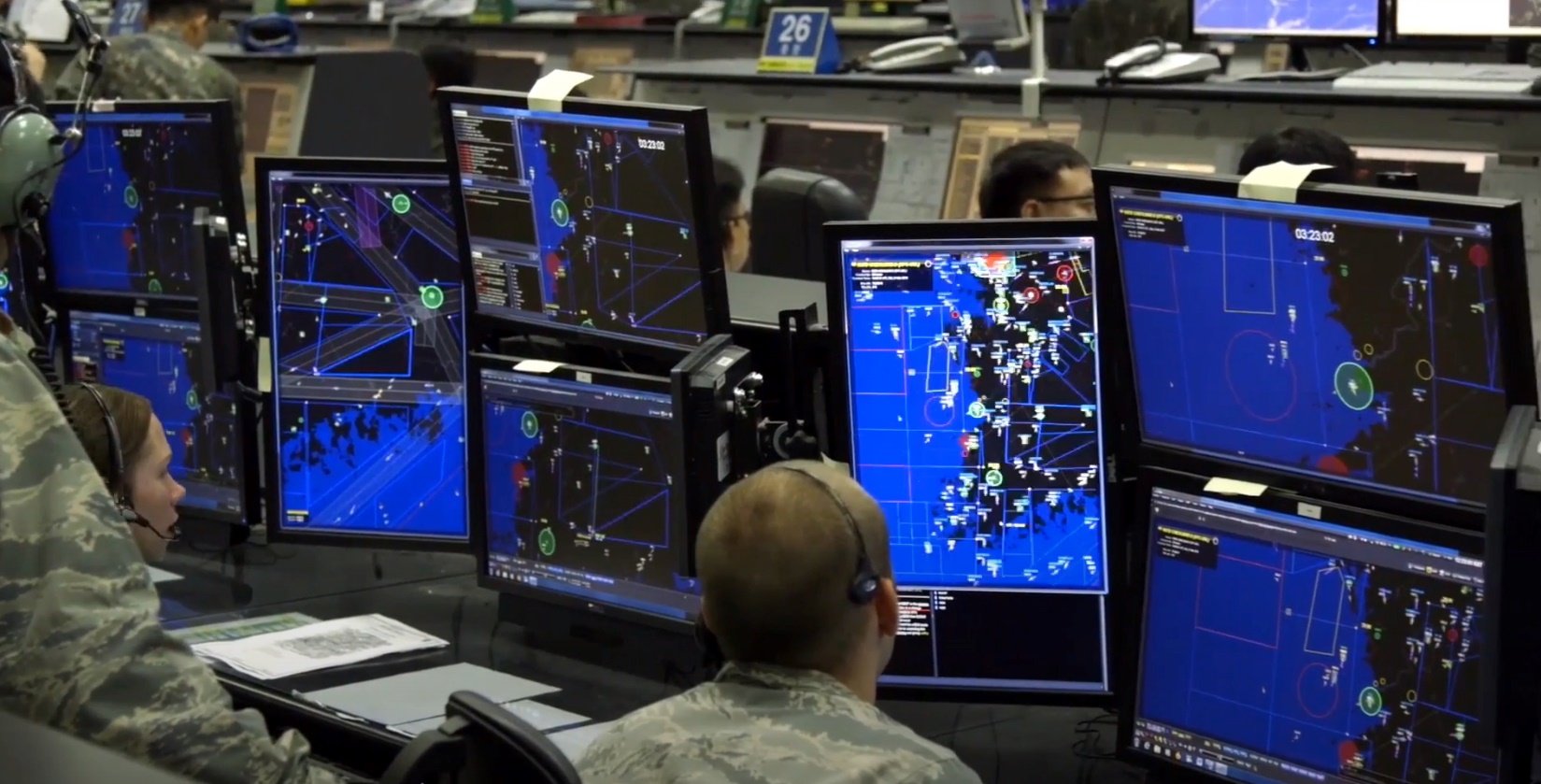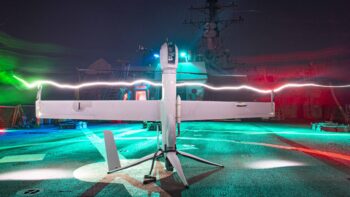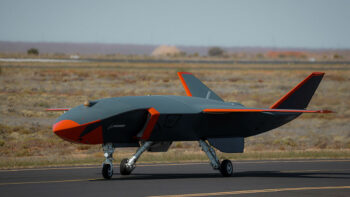
The capabilities of the Collins Intelligent Gateway were demonstrated on the KC-135 for Northern Edge 23, but it can also be deployed in ground or ground-mobile configurations.
In this Q&A with Solipsys president Raef Cronin, we discuss the organization’s role in the realigned RTX structure, the vital command and control capabilities it proved out at Northern Edge 23, and how platform-agnostic C2 along with a gateway data mesh network and cross-domain solutions enable Combined Joint All Domain Command Control.
Breaking Defense: Bring us up to speed on Solipsys and your role now as a part of Collins Aerospace.
Cronin: Solipsys capabilities rose to prominence after 9/11 when we responded to a DoD Urgent Operational Need and fielded the NORAD Contingency Suite (NCS) in 60 days. That provided for the first time a complete air picture of the entire continental United States.

Raef Cronin is president of Solipsys.
In 2003 Solipsys was acquired by Raytheon. The realignment under RTX this past July organized Solipsys, along with other critical JADC2 technologies, under Collins Aerospace. Solipsys is part of the newly formed Battle Management Command and Control & Autonomy (BMC2A) portfolio within Collins.
Solipsys solutions enhance command and control (C2) mission capabilities. They render entire mission threads on a single pane of glass and leverage a common software baseline for rapid fielding under any mission imaginable. Unlike other one-and-done systems, Solipsys solutions are tailorable, trusted, and constantly improving because of direct warfighter input.
Breaking Defense: Solipsys solutions recently played a role at Northern Edge 23? How did your systems perform; what results can you discuss?
Cronin: Solipsys was a critical part of the larger RTX exercises at Northern Edge. During Northern Edge 2023, we had two RTX businesses, Collins Aerospace and Raytheon, successfully demonstrate a suite of sensing and networking technologies that are foundational to the DoD’s Combined Joint All Domain Command and Control (CJADC2) warfighting strategy.
The Collins Aerospace team demonstrated a highly mature, resilient networking gateway called the ‘Intelligent Gateway’ enhanced with autonomous routing technologies that bridged disparate line-of-sight and beyond-line-of-sight networks across multiple security levels. The multi-level security networking allowed coalition partners to access data from U.S. networks and vice versa, enabling joint force commanders to direct coordinated operations in real-time interoperability. The Solipsys Battlespace Command, Control and Communications (BC3) software solution enabled new operational concepts relevant to expeditionary command and control.
During the exercise, battle managers were placed on non-traditional command and control platforms, in this case a KC-135 Stratotanker, to see how agile combat employment concepts may work in practice. The battle managers were able to assess simulated mission situations based on a combined situational awareness picture driven by both local theater operations and strategic operations centers in CONUS. The Solipsys software fused the common operating picture to enable the battle managers to make the best decisions based on all available information. By using the Solipsys BC3 software and interfacing it with the Intelligent Gateway, we created an airborne tactical operations center.
While these capabilities were demonstrated on the KC-135 for Northern Edge, they can be deployed in rapidly deployable ground configurations or even ground mobile and surface applications. Once we have the connectivity and the data the location and platform doesn’t matter as operationally relevant capabilities can be deployed across all domains, for platform-agnostic command and control, to give decision makers the best capabilities.
The large range space and terrain at the Northern Edge demonstration also simulated a relevant mission environment where Solipsys BC3 and the Intelligent Gateway extended networked C2 despite line-of-sight barriers. This experiment was very valuable to the Air Force as they assess future CONOPS, and we look forward to future events to support the warfighter.
Breaking Defense: What makes platform-agnostic C2 an urgent need?
Cronin: Currently there are extant command and control platforms, whether that be fixed infrastructure operations centers like the Air Operation Center, Control Reporting Center, or high-value air assets like the E-7 Airborne Early Warning & Control aircraft. This solution provides additional flexibility to tactical and theater C2 operations when some of those resources and capabilities may not be there, while still being fully informed.
The Department of Defense’s CJADC2 strategy emphasizes C2 as a priority need for achieving the ‘sense, make sense, and act’ capabilities necessary to outpace threats in highly contested environments.
Integrating C2 solutions on more platforms and assets ensures that decision makers and operators share a common operating picture they can act on based on verified, secure intelligence, even if an asset is lost or compromised.
Breaking Defense: What are some of the immediate applications for the Solipsys BC3 solution?
Cronin: BC3 can provide solutions that address needs for both traditional and emerging agile combat employment requirements such as the U.S. Air Force transitions from the E-3 Sentry Airborne Warning and Control Station to the E-7 Wedgetail. It can be quickly integrated onboard existing aircraft such as tanking assets and bombers that have the requisite comms gear already onboard.
Breaking Defense: Does it have potential for ground and surface components?
Cronin: The Air Force currently uses Solipsys BC3 in control and reporting centers and air operations centers, and recently deployed it as part of the Phase 1 Tactical Operation Center-Light prototypes as the USAF moves forward with the acquisition of the TOC-L capability. The Marine Corps has deployed a BC3 derivative as part of the Common Aviation Command & Control System (CAC2S) that is used as a common software baseline with numerous USMC systems including ATNAVICS, MADIS, and MRIC. This same baseline is also deployed by the USN as CAC2S Afloat on amphibious assault ships and transport docks with the potential for additional expansion.
BC3 shares a common software structure with the CAC2S system. When we deployed BC3 to support Mobility Guardian 2023 in the Pacific, air battle managers were able to communicate and share their air picture and C2 data with the Marine Air Control Squadron on the ground.
Breaking Defense: Is this C2 software solution COTS? Does that mean FAR Part 12?
Cronin: Solipsys BC3 can be licensed under FAR Part 12 but Solipsys is continuously open to other approaches with customers.
Breaking Defense: What’s next for Solipsys BC3?
Cronin: We deploy pre-release BC3 capability to the Shadow Operations Center – Nellis battle lab to get feedback on need, value, and implementation as part of something called Experimental BC3. We make any necessary updates from this feedback and incorporate the new capability in the next releases of BC3.
The next major step is to demonstrate integration with other ground systems where it can share sensor data back and forth and become a gateway for information for land and maritime assets. Collins Aerospace is looking at Valiant Shield 24 as an opportunity to do just that.
Breaking Defense: Final thoughts to share?
Cronin: As the CJADC2 strategy takes shape across all levels of the DoD, Solipsys BC3 is a C2 solution with a high TRL that meets warfighter needs today and provides a distributed C2 foundation for future missions.























